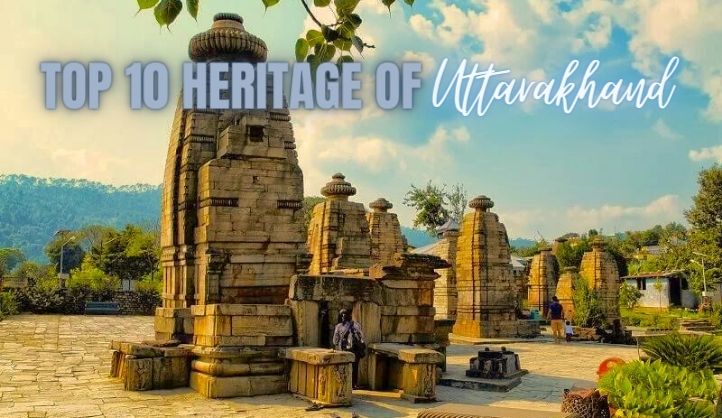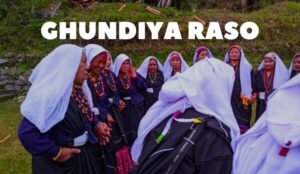Hello, fellow explorers! Ever wondered about the heritage of Uttarakhand? Get ready for a journey into a land where ancient temples, forts, and caves whisper tales of the past. Join us as we unravel the rich heritage of Uttarakhand, where history and nature create a magical blend. Pack your curiosity – we’re about to dive into the heart of Uttarakhand’s enchanting legacy! 🏰🌳✨
1. Katarmal Sun Temple
- Location: Katarmal village, Kumaon region, Almora District, Uttarakhand
- Significance: Dedicated to Surya, the Sun God, built in the 9th century by Katyuri ruler Katarmalla.
- Uniqueness: Exquisite stone carvings, unique architectural style, alignment allows first rays of sun to fall directly on the idol on specific days.
- Other Shrines: 45 shrines dedicated to Lord Shiva, Parvati, Lakshman, and Narayan within the complex.
- Best Time to Visit: November to February
The Katarmal Sun Temple is an 8th-century temple dedicated to the Sun God Surya. It is located in the Kumaon region of Uttarakhand, India. The temple is known for its exquisite stone carvings and unique architectural style. The temple’s alignment allows the first rays of the sun to fall directly on the idol of Surya on specific days, showcasing the astronomical knowledge of its builders.
2. Baijnath Temple
- Location: Bageshwar district, Kumaon division, Uttarakhand
- Significance: Dedicated to Lord Shiva, built in the 12th century.
- Architectural Beauty: Well-maintained, intricate carvings, attracts devotees from across India.
- Opening/Closing: No specific timings, closes just before sunset.
- Best Time to Visit: October to March
Dedicated to Lord Shiva, the Baijnath Temple dates back to the 12th century. It is located in the Kumaon region of Uttarakhand, India. The temple’s exquisite architecture and detailed carvings are well-known. The temple complex also houses several smaller temples dedicated to other deities.
3. Dwarahat
- Location: Kumaon Mountains, Almora, Uttarakhand
- Significance: Historical town with around 55 temples built by Katyuri Kings during the medieval period.
- Religious Importance: Renowned for spiritual rejuvenation and peacefulness.
- Activities: Temple visits, nature walks, meditation.
- Best Time to Visit: Anytime except monsoon (August-September)
4. Bageshwar
- Location: Confluence of Saryu, Gomti, and Bhagirathi rivers, Bageshwar District in Uttarakhand
- Significance: Numerous ancient temples frequented by devotees and tourists.
- Temples: Baghnath Temple, Bamani Temple, Chandika Temple, Sriharu Temple, Gauri Udiyar.
- Activities: Trekking (Pindari Glacier, Pandusthal), temple visits, sightseeing.
- Best Time to Visit: October to March
5. Narendra Nagar
- Location: In Tehri Garhwal district, Uttarakhand
- Significance: Scenic beauty, panoramic views of River Ganga and Doon valley.
- Activities: Sightseeing, nature walks, boat rides.
- Best Time to Visit: November to March
6. Patal Bhuvaneshwar Cave
- Location: 14 km from Gangolihat in the Pithoragarh district of Uttarakhand
- Significance: Series of limestone caves starting with Patal Bhuvaneshwar, 160m long and 90ft deep.
- Religious Importance: Temple of Lord Shiva and 33 other deities inside the cave.
- Discovery: Believed to be discovered by King Ritupurna of the Surya Dynasty during Treta Yuga.
- Best Time to Visit: October to March
The Patal Bhuvaneshwar Cave is a limestone cave located in the Garhwal region of Uttarakhand, India. It is known for its stalactites and stalagmites, and its religious significance. According to legend, Lord Shiva resides in the cave.
7. Nainital
- Location: Kumaon region, Uttarakhand
- Significance: Scenic beauty, lakes, popular weekend destination.
- Historical Importance: Mukhteshwar Temple (over 350 years old).
- Activities: Boating, trekking, shopping, sightseeing.
- Entry Fee: May apply to some attractions.
- Best Time to Visit: October to June
8. Pithoragarh Fort
- Location: Pithoragarh, Uttarakhand
- Significance: Built in 1789 by Gorkhas after invading the town.
- Architectural Style: Offers captivating views of the Kali Kumaon region.
- Activities: Sightseeing, photography, historical exploration.
- Best Time to Visit: October to February
The Pithoragarh Fort is a 17th-century fort located in the Kumaon region of Uttarakhand, India. It was built by the Chand Kings of Kumaon. The fort is now a museum, and it offers panoramic views of the surrounding area.
9. Banasur Ka Kila
- Location: 7km from Lohaghat, 20km from Champawat, Uttarakhand
- Significance: Believed to be the capital of demon Vanasur, defeated by Lord Krishna.
- Current State: Ruins of the fort offering spectacular views.
- Activities: Hiking, photography, exploring the ruins.
- Best Time to Visit: October to December
The Banasur Ka Kila is a 14th-century fort located in the Garhwal region of Uttarakhand, India. It is said to have been built by the demon king Banasur. The fort is now in ruins, but it still offers a glimpse into the region’s rich history.
10. Kalsi
- Location: Small village in Dehradun district, Uttarakhand
- Historical Significance: Timli Pass (battle between British and Gorkhas), Ashokan Rock Edict (253 BC).
- Ashokan Rock Edict: Pear-shaped quartz rock with the Brahmi script.
Kalsi is a town located in the Dehradun district of Uttarakhand, India. It is known for its Ashokan edicts, which are rock inscriptions dating back to the 3rd century BCE. The edicts record the teachings of the Mauryan emperor Ashoka.
Conclusion
And that’s a wrap on our trip through Uttarakhand! We checked out old temples, cool forts, and awesome nature spots that make this place super colorful. Imagine Uttarakhand as a big, cool painting full of history and good vibes. Come check it out – there’s a lot to see and feel in this amazing state! 🏰🌲✨
FAQs Related to the Heritage of Uttarakhand
1. What essentials should I pack for exploring the heritage sites in Uttarakhand?
Pack comfortable clothing, suitable for temple visits and historical sites. Don’t forget a camera, sunscreen, and a hat for outdoor exploration.
2. Is there a network problem in remote heritage sites in Uttarakhand?
While major heritage sites usually have decent network coverage, some remote areas may experience limited connectivity. It’s recommended to check with your service provider and carry a local SIM card if needed.
3. When is the best time to visit Uttarakhand’s heritage sites to enjoy pleasant weather and avoid network issues?
Optimal months for heritage exploration are October to March. During this period, the weather is pleasant, and network connectivity is generally stable.
4. Are there any specific safety precautions for visiting heritage sites and ancient ruins in Uttarakhand?
Take care around ancient structures, follow designated paths, and respect any guidelines provided by site authorities. Engage a local guide for a more enriching experience.
5. Do I need any permits to visit specific heritage sites or temples in Uttarakhand?
Some temples or historical sites may require permits. Check with local authorities or tour operators in advance to ensure you have the necessary permissions.





